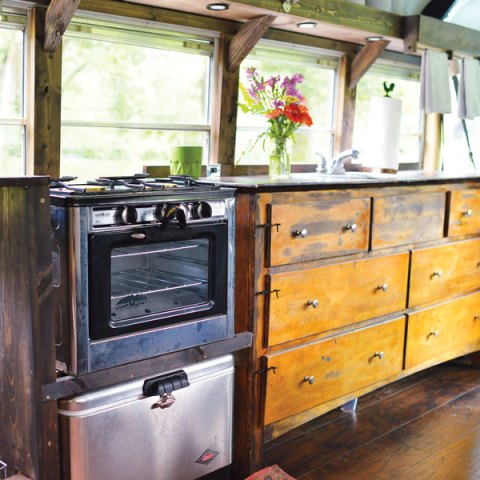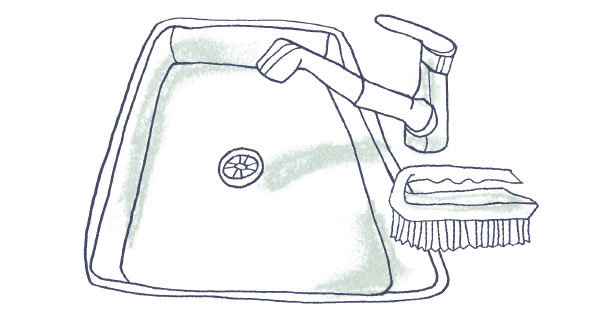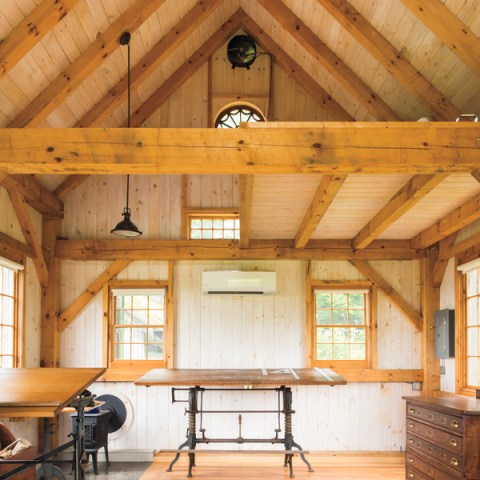Project: Build Your Own Seedling Rack
Get a jump on the growing season with Spike Carlsen’s plans for a homebuilt seedling rack made with PVC pipe and plywood.
A seedling rack provides a space-saving vertical garden to give your plants an indoor head start. This rack, made primarily from inexpensive PVC pipe and fittings, can accommodate grow lights to give your seedlings an even better jump start. Since seedling racks can be space wasters for the 10 months of the year you don’t need them, this PVC rack is designed to be easily disassembled and stowed.
You can adjust the height and spacing of the platforms by adjusting the length of the legs (D, E).
Safety note: If you have climbing kids or curious cats, or just want to play it safe, prevent your rack from tipping by securing it to the wall using pipe straps or L brackets. Also, make certain the cord or cords running from the lights to the outlet don’t create a tripping hazard.
As the weather warms, you can move your seedling rack outdoors, cover the framework with plastic film, and use it for a greenhouse. The peaked roof comes in handy for shedding rain. Secure it to something sturdy so it doesn’t topple.
Materials*:
- Six 10-foot pieces 1″ PVC pipe
- Twenty-four 1″ PVC T-fittings
- Four 45-degree 1″ PVC elbows
- Two 1″ × 1″ × 1″ PVC side outlet elbows
- One and a half 4 × 8-foot sheets ¾” plywood
- White silicone caulk
* Buy T-fittings in packs of 10 to save money. Instead of two Ts at each corner, you can use a single 4-way side outlet T. These simplify the project but cost three to four times as much as a pair of standard Ts.
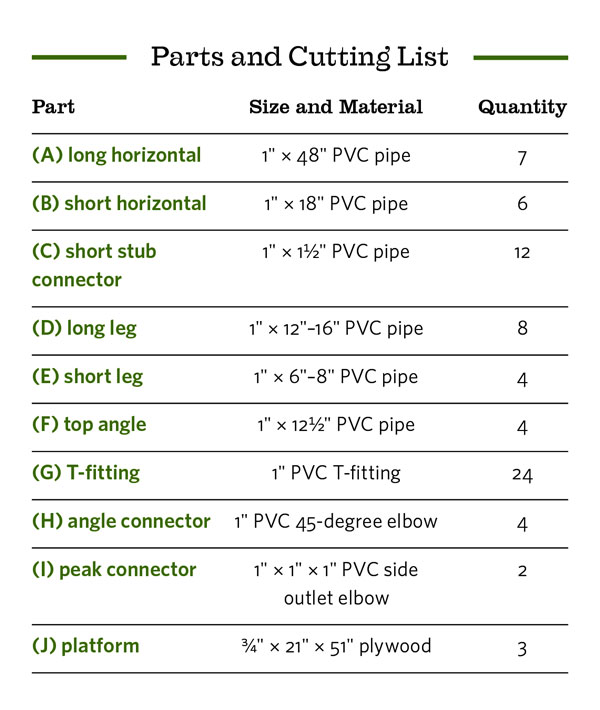
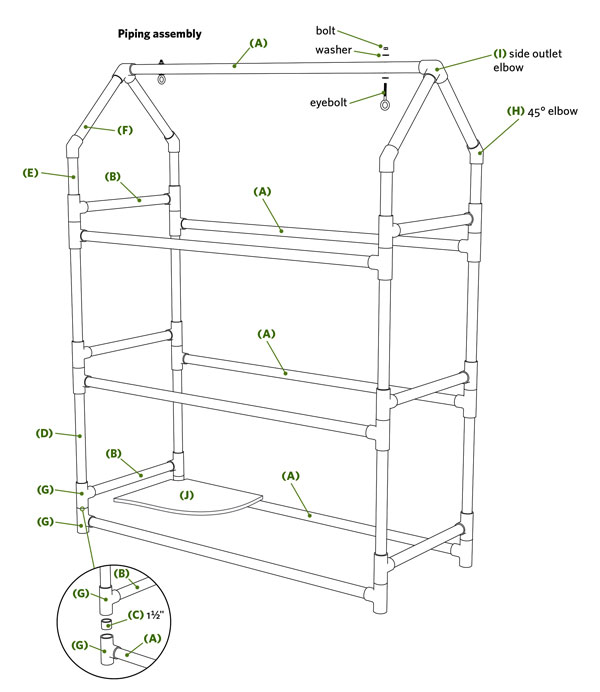
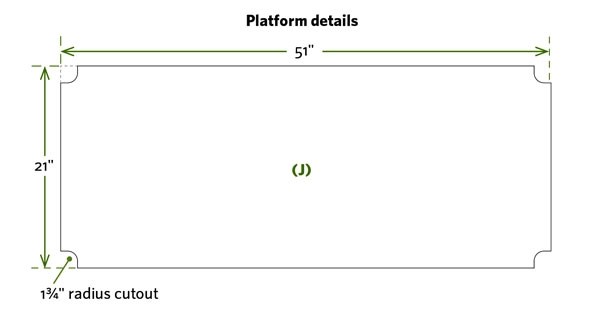
Directions:
Step 1: Cut the PVC pipe sections (A, B, C, D, E, F) to length, using a hand miter box, power miter saw, or fine-tooth handsaw. To make the best use of pipe materials (which normally come in 10-foot lengths), cut the 48″ and 18″ horizontals first, then the legs, and finally the short stub connectors. Watch your fingers when you’re working with short pieces! Use sandpaper to smooth the cut edges. If you want to remove the factory markings on the pipe, rub the area with a cloth dampened in acetone. Wear gloves, and do this outside. Note: Adjust the length of the long (D) and short (E) legs according to the heights of the seedlings you intend to grow.
Step 2: Cut the three plywood platforms (J) to size as shown. Use a jigsaw to cut the curved notches in the corners.
Step 3: Secure Ts (G) to both ends of the long (A) and short (B) horizontals. Use white silicone caulk, rather than pipe cement, since your joints don’t need to be watertight, and caulk will give you more time to fiddle with the orientation of the pieces. When you’re done, you’ll have a dozen pieces of pipe with Ts on both ends; six of these frame assemblies will be long, and six will be short.
Step 4: Slide the 1½” stubs (C) into the tops of the Ts at the ends of the long frame assemblies (A, G). Note: Do not glue or caulk these or any remaining joints if you want to be able to disassemble the rack for storage. Slip one short frame assembly (B, G) over the stubs of two long frame assemblies (A, G) to create a U shape. Lay a platform (J) in place, and then add the second short frame assembly (B, G) to complete the rectangular frame of piping. You must assemble the rack in this order so that you get the platforms in place. Note: Even when they’re not cemented together, PVC pipe and fittings can be a bear to take apart. To make the legs easier to remove for storage, apply furniture wax to the ends and then buff with a rag before assembling the parts.
Step 5: Insert the legs (D) into the top sockets of the Ts; then work upward, assembling the frames and inserting the plywood platforms as you go. Create the peak by assembling the parts as shown in Piping assembly (above).
Step 6: Hang the lower two grow lights from eye bolts secured near the ends of the platforms. Hang the upper grow light from eye bolts secured to the upper long horizontal (A). Adjust the heights of the lights by moving the S-hooks to different links in the chain. Use tape to secure the lights’ cords to the legs to keep them organized. To minimize the number of cords running across the floor, mount a multi-outlet strip to the rack for plugging in the lights, and then run a single extension cord to the wall outlet. You can add a timer to automate the on-off cycles.
TEXT AND ILLUSTRATIONS EXCERPTED FROM THE BACKYARD HOMESTEAD BOOK OF BUILDING PROJECTS © 2014 BY SPIKE CARLSEN. SEEDLING RACK DIAGRAM BY BRUCE KIEFFER. ALL RIGHTS RESERVED.
Learn More
Gardeners, small farmers, and outdoor living enthusiasts will love this compilation of 76 rustic DIY projects. From plant supports and clotheslines to a chicken coop, a greenhouse, and a root cellar with storage bins, most of the projects are suitable for complete novices, and all use just basic tools and easy-to-find materials. You’ll find techniques to build whatever your outdoor world is missing, with additional tips to live sustainably, happily, and independently.
Also available in this series: The Backyard Homestead, The Backyard Homestead Seasonal Planner, The Backyard Homestead Guide to Raising Farm Animals, and The Backyard Homestead Book of Kitchen Know-How.





